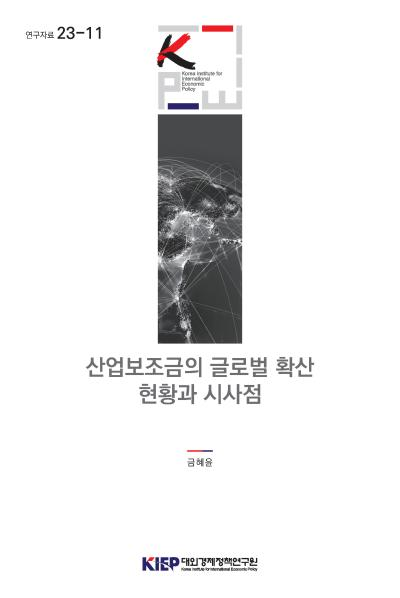Policy Reference
PUBLISH
Policy Reference
To list

Proliferation of Industrial Subsidies: Current State and Its Implications
Trade policy, Subsidy
Author Hyeyoon Keum Series 23-11 Language Korean Date 2023.12.29
The recent trade environment has not been favorable for Korea. Since 2018, the U.S.-China trade conflict has intensified, leading to more protectionist tendencies globally, and since 2020, the COVID-19 pandemic has led major countries to build more resilient supply chains. As a result, subsidies have become increasingly important as a useful trade policy to address emergencies or market failures. But subsidies have the potential to distort trade and competition depending on who they target and how they are administered. And Korea, with its high trade dependence (96.8% as of 2022), can be particularly affected by the subsidy policies of its trading partners. However, the global proliferation of subsidies is likely to continue for the foreseeable future, and it is time to take a closer look at the current state of subsidy policies.
In this study, I use statistics from the Global Trade Alert (GTA) database, which contains information on government intervention by country from November 2008 to April 2023, and the Corporate Subsidy Inventory, which contains information on subsidies only, to examine the status of industrial subsidies in detail. We also identify Korean industries that are associated with subsidies in major countries and analyze the trade changes of Korean industries before and after the implementation of industrial subsidy policies in major trading partners.
During the analysis period, the number of industrial subsidy policies increased significantly globally. The number of subsidy measures increased from 92 in 2008 to 1,511 in 2021, with 147 policies announced in a four-month period in 2023. The country with the most industrial subsidy policies over the same period was China, with a total of 3,770, followed by the EU, the US, Canada, Japan, and India. Each of these countries' subsidy measures covered a wide range of products and industries and affected almost every country in the world, including Korea. Financial grants were the most common type of subsidy throughout the period, accounting for 35.9% of all measures, followed by trade finance and state loans. In addition, tax or social insurance reliefs and production subsidies have been increasingly announced in recent years.
Subsidies were reported in various manufacturing sectors, with the most relevant industry being HS84 (machinery), followed by HS85 (electrical equipment), HS52 (cotton), and HS87 (automobiles). In addition, there were many cases of subsidies in industries such as optical and precision equipment, plastics, and steel. Since 2018, HS84, HS85, and HS87 have been the most frequently subsidized industries. Since these are mostly industries where Korea is competitive in the global market or has a high proportion of exports, the more widespead the subsidy policies become, the more likely it is that Korea’s export industries will be negatively affected.
China, the EU, and the U.S. were the major countries that used industrial subsidies during the period analyzed, but the number of subsidy announcements, the types of subsidies used, and the sectors with many subsidies differed somewhat by country. Of these major countries’ policies, the share of policies affecting Korea was 96.7% in China, 56% in the EU, and 50.9% in the U.S. In China, automobiles, machinery, pharmaceuticals, and semiconductors were the most frequently subsidized products; in the EU, environmental machinery, chemicals, and plastics; and in the US, rechargeable batteries and semiconductors.
Based on the industrial subsidy announcements made by major countries (China, EU, and US) since 2018, we identified 280 export items and 281 import items at the 6-digit HS code level that particularly affect Korea. Both exports and imports were dominated by the machinery, electrical equipment, and automobile industries, as is the case globally. The results show that exports to the rest of the world are increasing, while the share of exports to major countries is decreasing. These results suggest that industrial subsidies in major countries may have a negative impact on Korean exports to these countries. Meanwhile, imports from major countries grew faster than imports from the rest of the world in terms of the average annual growth rate over the 2012-2022 period. However, since 2018, imports from major countries and the world as a whole have grown at similar rates. However, Korea is a significant importer of items that major countries subsidize for their own companies, and if this situation continues, there is a possibility that domestic products may be replaced by imports from major countries.
Based on the above analysis, this study suggests that the Korean government’s role in responding to the proliferation of industrial subsidies is to 1) lead international efforts to create a fair competitive environment, 2) expand channels of communication with major trading partners, and 3) establish effective policies to improve the competitiveness of Korean companies.
Sales Info
| Quantity/Size | 140 |
|---|---|
| Sale Price | 7 $ |
 공공저작물 자유이용허락 표시기준 (공공누리, KOGL) 제4유형
공공저작물 자유이용허락 표시기준 (공공누리, KOGL) 제4유형
대외경제정책연구원의 본 공공저작물은 "공공누리 제4유형 : 출처표시 + 상업적 금지 + 변경금지” 조건에 따라 이용할 수 있습니다. 저작권정책 참조
